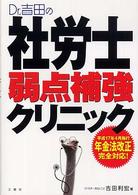Full Description
Part of the acclaimed 'Documents of Contemporary Art' series of anthologies . With the emergence of conceptual art in the mid-1960s, the traditional notion of the studio became at least partly obsolete. Other sites emerged for the generation of art, leading to the idea of "post-studio practice." But the studio never went away; it was continually reinvented in response to new realities. This collection, expanding on current critical interest in issues of production and situation, looks at the evolution of studio - and 'post-studio'- practice over the last half century. In recent decades many artists have turned their studios into offices from which they organize a multiplicity of operations and interactions. Others use the studio as a quasi-exhibition space, or work on a laptop computer - mobile, flexible, and ready to follow the next commission. Among the topics surveyed here are the changing portrayal and experience of the artist's role since 1960; the diversity of current studio and post-studio practice; the critical strategies of artists who have used the studio situation as the subject or point of origin for their work; the insights to be gained from archival studio projects; and the expanded field of production that arises from responding to new conditions in the world outside the studio. The essays and artists' statements in this volume explore these questions with a focus on examining the studio's transition from a workshop for physical production to a space with potential for multiple forms of creation and participation. Writers and artists surveyed include: Vito Acconci, Alexander Alberro, Jennifer Allen, Svetlana Alpers, Edgar Arceneaux, Michael Auping, Francis Bacon, Albrecht Barthel, Mary Bergstein, Iwona Blazwick, Louise Bourgeois, Constantin Brancusi, Daniel Buren, Sarah Burns, Aimee Chang, Judy Chicago, Jane Collings, Lynne Cooke, Barbara Dawson, Jeffrey Deitch, Manthia Diawara, Brian Dillon, Marcel Duchamp, Briony Fer, Elena Filipovic, Jori Finkel, Alberto Giacometti, Jack Goldstein, Ulrike Groos, Carles Guerra, Elizabeth Harney, Herzog & de Meuron, Carsten Hoeller, Amelia Jones, Caitlin Jones, Caroline A. Jones, Seydou Keita, Martin Kippenberger, Edward Krasinski, Bernd Krauss, Yayoi Kusama, Sanford Kwinter, Henri Lefebvre, Herbert Molderings, Valerie Mrejen, Takashi Murakami, Joanna Mytkowska, Hans Namuth, Bruce Nauman, Sune Nordgren, Hans Ulrich Obrist, Francis V. O'Connor, Brian O'Doherty, Gabriel Orozco, Rozsika Parker, Jackson Pollock, Andrzej Przywara, Lane Relyea, Frances Richard, Gerhard Richter, Anthony Robbin, Martha Rosler, Dieter Roth, Carolee Schneemann, Robert Smithson, Ann Temkin, Sarah Thornton, Wolfgang Tillmans, Coosje van Bruggen, Jan Verwoert, Ian Wallace, Bernadette Walter, Steven Watson, Lawrence Weiner, Lawrence Weschler, Francesca Woodman, Jon Wood, Linda Yablonsky and Phillip Zarrilli.
Contents
Introduction; Being the Artist; Working With the Situation; Retracing the Steps; Facing the World; Biographical Notes; Bibliography; Index, Acknowledgements.








